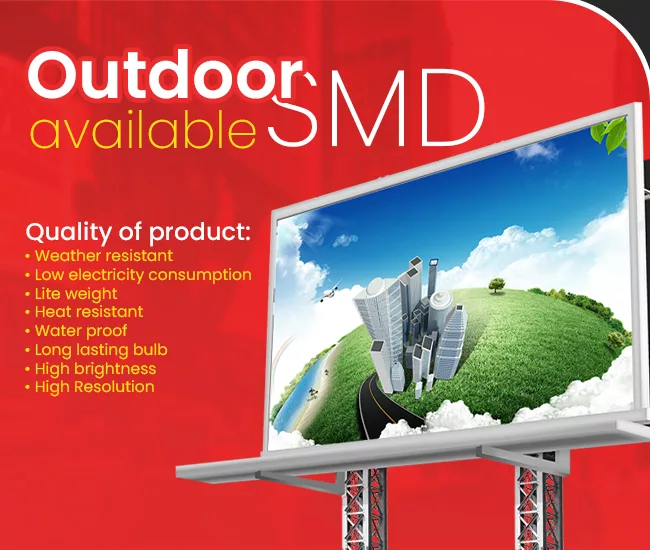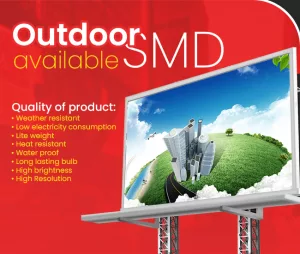How to Choose the Perfect SMD Screen for Your Business
Outline
- Introduction
- Importance of Digital Displays in Business
- Brief Overview of SMD Screens
- What is an SMD Screen?
- Definition and Basic Functionality
- How SMD Screens Differ from Other Types of Displays
- Benefits of SMD Screens
- High Resolution and Clarity
- Energy Efficiency
- Durability and Longevity
- Flexibility in Design
- Types of SMD Screens
- Indoor SMD Screens
- Outdoor SMD Screens
- Flexible SMD Screens
- Key Features to Look for in an SMD Screen
- Resolution
- Brightness
- Contrast Ratio
- Refresh Rate
- Viewing Angle
- Understanding Pixel Pitch
- Definition of Pixel Pitch
- How Pixel Pitch Affects Image Quality
- Choosing the Right Pixel Pitch for Your Needs
- Screen Size and Aspect Ratio
- Determining the Right Size for Your Space
- Common Aspect Ratios and Their Uses
- Choosing Between Indoor and Outdoor SMD Screens
- Environmental Considerations
- Brightness and Weather Resistance
- Installation and Maintenance
- Professional Installation vs. DIY
- Routine Maintenance Tips
- Troubleshooting Common Issues
- Budget Considerations
- Cost vs. Quality
- Long-Term Value and ROI
- Where to Buy SMD Screens
- Trusted Manufacturers and Suppliers
- Online vs. Offline Purchasing
- Case Studies of Successful SMD Screen Implementations
- Retail Stores
- Corporate Offices
- Public Spaces
- Future Trends in SMD Screen Technology
- Innovations to Watch
- Potential Impact on Business
- Common Mistakes to Avoid When Choosing an SMD Screen
- Overlooking Key Specifications
- Ignoring Maintenance Needs
- Not Considering the Environment
- Conclusion
- Recap of Key Points
- Final Tips for Making the Best Choice
- FAQs
- What is the difference between SMD and traditional LED screens?
- How do I clean and maintain my SMD screen?
- Can SMD screens be used for outdoor advertising?
- What factors affect the lifespan of an SMD screen?
- How do I know if I need a flexible SMD screen?
Introduction
In today’s digital age, having a visually appealing and effective display can significantly impact your business’s success. Whether you’re looking to attract customers, provide information, or enhance your brand image, choosing the right SMD (Surface-Mount Device) screen is crucial. But with so many options available, how do you pick the perfect one? Let’s dive into everything you need to know to make an informed decision.
What is an SMD Screen?
An SMD screen is a type of LED display that uses surface-mount technology to create high-resolution visuals. Unlike traditional LEDs, SMD screens have their components mounted directly onto the surface of the circuit board, allowing for a more compact and efficient design. This technology results in vibrant, clear images and is widely used in various applications, from retail to corporate settings.
Benefits of SMD Screens
High Resolution and Clarity
SMD screens offer superior resolution, making them ideal for displaying detailed content. Whether you’re showcasing products or delivering presentations, the clarity is unmatched.
Energy Efficiency
Compared to other display types, SMD screens consume less power, which can lead to significant energy savings over time.
Durability and Longevity
Built to withstand the rigors of continuous use, SMD screens are known for their durability. They offer long lifespans, reducing the need for frequent replacements.
Flexibility in Design
SMD screens come in various shapes and sizes, allowing businesses to customize their displays to fit specific spaces and aesthetic preferences.
Types of SMD Screens
Indoor SMD Screens
Designed for interior use, indoor SMD screens are perfect for environments where lighting can be controlled, such as retail stores and conference rooms.
Outdoor SMD Screens
These screens are built to withstand harsh weather conditions and provide high brightness levels to remain visible in direct sunlight.
Flexible SMD Screens
Ideal for creative installations, flexible SMD screens can be curved or bent to fit unique architectural designs.
Key Features to Look for in an SMD Screen
Resolution
Higher resolution means clearer and more detailed images. Choose a resolution that matches your content needs and viewing distance.
Brightness
Ensure the screen’s brightness level is adequate for its environment. Outdoor screens, for example, require higher brightness levels to combat sunlight.
Contrast Ratio
A higher contrast ratio improves the screen’s ability to display different shades of color, enhancing overall image quality.
Refresh Rate
A higher refresh rate results in smoother motion, which is important for video displays and interactive content.
Viewing Angle
Wide viewing angles ensure that the screen remains clear and readable from various positions, crucial for public displays.
Understanding Pixel Pitch
Definition of Pixel Pitch
Pixel pitch refers to the distance between the centers of two adjacent pixels. It is measured in millimeters.
How Pixel Pitch Affects Image Quality
A smaller pixel pitch means higher pixel density, resulting in sharper images. However, it can also increase the cost.
Choosing the Right Pixel Pitch for Your Needs
For close-up viewing, a smaller pixel pitch is ideal. For larger displays viewed from a distance, a larger pixel pitch will suffice.
Screen Size and Aspect Ratio
Determining the Right Size for Your Space
Measure your space and consider the viewing distance to determine the optimal screen size.
Common Aspect Ratios and Their Uses
Standard aspect ratios include 4:3 and 16:9. The choice depends on your content format and viewing preferences.
Choosing Between Indoor and Outdoor SMD Screens
Environmental Considerations
Outdoor screens must withstand weather elements such as rain, wind, and extreme temperatures.
Brightness and Weather Resistance
Outdoor screens need high brightness and weather-resistant features to ensure longevity and visibility.
Installation and Maintenance
Professional Installation vs. DIY
While DIY installation can save costs, professional installation ensures optimal performance and longevity.
Routine Maintenance Tips
Regular cleaning and inspection can prevent issues and prolong the screen’s life.
Troubleshooting Common Issues
Learn basic troubleshooting to address common problems such as dead pixels or connectivity issues.
Budget Considerations
Cost vs. Quality
Balancing cost with quality is crucial. Investing in a high-quality screen may have higher upfront costs but offers better performance and durability.
Long-Term Value and ROI
Consider the long-term benefits and return on investment. A more expensive but reliable screen can save money on repairs and replacements.
Where to Buy SMD Screens
Trusted Manufacturers and Suppliers
BIA SMD Screens is reputable manufacturer and supplies quality product.
Online vs. Offline Purchasing
Online purchasing offers convenience and often better prices, while offline purchasing allows for hands-on inspection.
Case Studies of Successful SMD Screen Implementations
Retail Stores
Retailers use SMD screens to enhance customer experience and promote products effectively.
Corporate Offices
In corporate settings, SMD screens are used for presentations, video conferencing, and information dissemination.
Public Spaces
Public spaces like airports and train stations use SMD screens for real-time updates and advertisements.
Future Trends in SMD Screen Technology
Innovations to Watch
Stay updated on emerging technologies such as microLED and improved pixel pitches.
Potential Impact on Business
Advancements in SMD technology can provide businesses with more efficient and engaging display solutions.
Common Mistakes to Avoid When Choosing an SMD Screen
Overlooking Key Specifications
Ensure you understand and prioritize essential specifications like resolution and brightness.
Ignoring Maintenance Needs
Regular maintenance is crucial to keep your screen functioning optimally.
Not Considering the Environment
Choose a screen that suits your environment, whether it’s indoor or outdoor.
Conclusion
Choosing the perfect SMD screen for your business involves careful consideration of various factors, from technical specifications to environmental needs. By understanding the benefits, features, and potential pitfalls, you can make an informed decision that will enhance your business’s visual appeal and operational efficiency.
FAQs For Perfect SMD Screen for your business
What is the difference between SMD and traditional LED screens?
SMD screens use surface-mount technology for higher resolution and better color consistency, while traditional LED screens may have larger pixels and less clarity.
How do I clean and maintain my SMD screen?
Regularly dust the screen with a soft cloth and use appropriate cleaning solutions for tougher stains. Ensure proper ventilation to prevent overheating.
Can SMD screens be used for outdoor advertising?
Yes, outdoor SMD screens are designed to be weather-resistant and have higher brightness levels to remain visible in direct sunlight.
What factors affect the lifespan of an SMD screen?
Factors include usage hours, environmental conditions, and maintenance practices. Regular upkeep and proper installation can prolong the lifespan.
How do I know if I need a flexible SMD screen?
Flexible SMD screens are ideal for creative installations or spaces with curved surfaces. Assess your design requirements to determine if flexibility is necessary.



